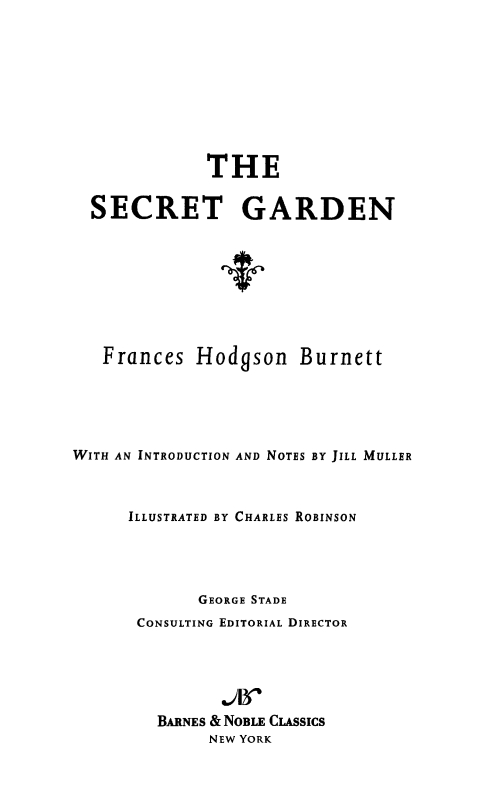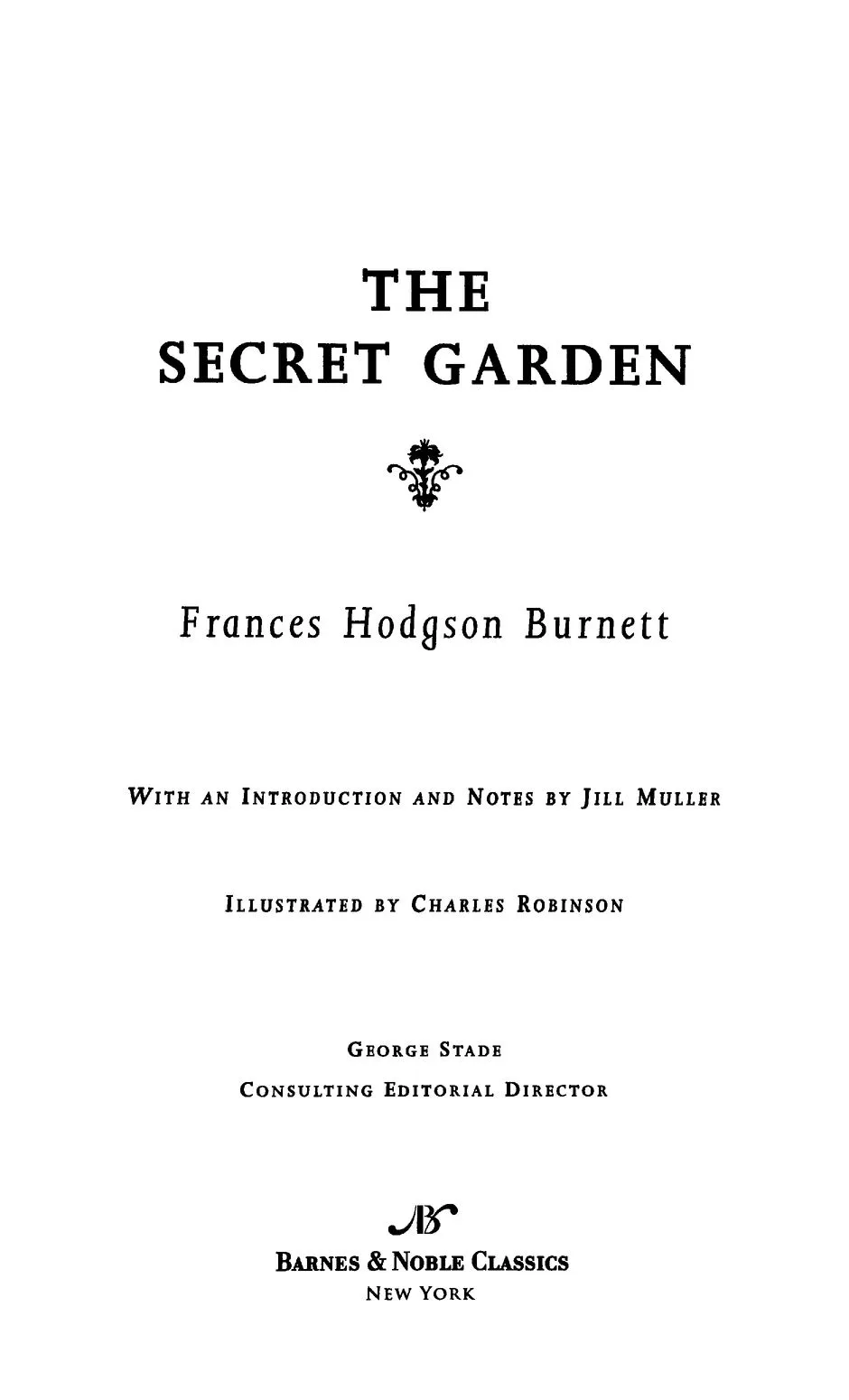The Secret Garden

Table of Contents
FROM THE PAGES OF THE SECRET GARDEN
Title Page
Copyright Page
FRANCES HODGSON BURNETT
THE WORLD OF FRANCES HODGSON BURNETT AND THE SECRET GARDEN
Introduction
Chapter 1 - There’s No One Left
Chapter 2 - Mistress Mary Quite Contrary
Chapter 3 - Across the Moor
Chapter 4 - Martha
Chapter 5 - The Cry in the Corridor
Chapter 6 - “There Was Some One Crying—There Was”
Chapter 7 - The Key of the Garden
Chapter 8 - The Robin Who Showed the Way
Chapter 9 - The Strangest House
Chapter 10 - Dickon
Chapter 11 - The Nest of the Missel Thrush
Chapter 12 - “Might I Have a Bit of Earth?”
Chapter 13 - “I Am Colin”
Chapter 14 - A Young Rajah
Chapter 15 - Nest Building
Chapter 16 - “I Won’t!” Said Mary
Chapter 17 - A Tantrum
Chapter 18 - “Tha’ Munnot Waste No Time”
Chapter 19 - “It Has Come!”
Chapter 20 - “I Shall Live Forever”
Chapter 21 - Ben Weatherstaff
Chapter 22 - When the Sun Went Down
Chapter 23 - Magic
Chapter 24 - “Let Them Laugh”
Chapter 25 - The Curtain
Chapter 26 - “It’s Mother!”
Chapter 27 - In the Garden
ENDNOTES
INSPIRED BY THE SECRET GARDEN
COMMENTS & QUESTIONS
FOR FURTHER READING
FROM THE PAGES OF THE SECRET GARDEN
When Mary Lennox was sent to Misselthwaite Manor to live with her uncle everybody said she was the most disagreeable-looking child ever seen. It was true, too.
(page 7)
It had not been the custom that Mistress Mary should do anything but stand and allow herself to be dressed like a doll, but before she was ready for breakfast she began to suspect that her life at Misselthwaite Manor would end by teaching her a number of things quite new to her.
(page 27)
“Would you make friends with me?” she said to the robin just as if she was speaking to a person. “Would you?”
(page 36)
“I am the first person who has spoken in here for ten years.”
(page 65)
Mary was an odd, determined little person, and now she had something interesting to be determined about, she was very much absorbed, indeed. She worked and dug and pulled up weeds steadily, only becoming more pleased with her work every hour instead of tiring of it.
(page 73)
As she came closer to him she noticed that there was a clean fresh scent of heather and grass and leaves about him, almost as if he were made of them. She liked it very much and when she looked into his funny face with the red cheeks and round blue eyes she forgot that she had felt shy.
(page 80)
“I am like this always, ill and having to lie down. My father won’t let people talk me over either. The servants are not allowed to speak about me. If I live I may be a hunchback, but I shan’t live.”
(page 102)
“I don’t think I ever really wanted to see anything before, but I want to see that garden. I want the key dug up. I want the door unlocked.”
(page 105)
“No lad could get well as thought them sort o’ things.”
(page 127)
“He’s having one of those tantrums the nurse calls hysterics. How awful it sounds.”
(page 136)
“Mary! Dickon! I shall get well! And I shall live forever and ever and ever!”
(page 164)
She was saying it to Colin because she wanted to make Magic and keep him on his feet looking like that. She could not bear that he should give in before Ben Weatherstaff. He did not give in. She was uplifted by a sudden feeling that he looked quite beautiful in spite of his thinness.
(page 175)
They always called it Magic and indeed it seemed like it in the months that followed—the wonderful months—the radiant months—the amazing ones. Oh! the things which happened in that garden! If you have never had a garden you cannot understand, and if you have had a garden you will know that it would take a whole book to describe all that came to pass there.
(page 180)
One of the new things people began to find out in the last century was that thoughts—just mere thoughts—are as powerful as electric batteries—as good for one as sunlight is, or as bad for one as poison. To let a sad thought or a bad one get into your mind is as dangerous as letting a scarlet fever germ get into your body.
(page 214)
By his side with his head up in the air and his eyes full of laughter walked as strongly and steadily as any boy in Yorkshire—Master Colin!
(page 227)


Published by Barnes & Noble Books
122 Fifth Avenue
New York, NY 10011
www.BookishMall.com.com/classics
The Secret Garden was first published in 1911.
Published in 2005 by Barnes & Noble Classics with new Introduction,
Notes, Biography, Chronology, Inspired By, Comments & Questions,
and For Further Reading.
Introduction, Notes, and For Further Reading
Copyright © 2005 by Jill Muller.
Note on Frances Hodgson Burnett, The World of
Frances Hodgson Burnett and The Secret Garden, Inspired by
The Secret Garden, and Comments & Questions
Copyright © 2005 by Barnes & Noble, Inc.
All rights reserved. No part of this publication may be reproduced
or transmitted in any form or by any means, electronic or mechanical, including
photocopy, recording, or any information storage and retrieval system,
without the prior written permission of the publisher.
Barnes & Noble Classics and the Barnes & Noble Classics
colophon are trademarks of Barnes & Noble, Inc.
The Secret Garden
ISBN-13: 978-1-59308-277-2 ISBN-10: 1-59308-277-0
eISBN : 978-1-411-43312-0
LC Control Number 2005922120
Produced and published in conjunction with:
Fine Creative Media, Inc.
322 Eighth Avenue
New York, NY 10001
Michael J. Fine, President and Publisher
Printed in the United States of America
QM
3 5 7 9 10 8 6 4
FRANCES HODGSON BURNETT
Imagine children’s books as popular as the Harry Potter series is today, and you have some idea of the iconic status Frances Hodgson Burnett earned from her writing more than a century ago. Frances was born in Manchester, England, in 1849. Her prosperous father owned a home-furnishings business, supported by customers made wealthy through the Manchester textile industry. But when her father died in 1853 and then cotton imports ceased when the American Civil War began, Frances’s family became almost penniless. To survive, her mother moved her five children to rural Tennessee in 1865.
A naturally gifted storyteller, Frances charmed family and friends with her keen imagination. In spite of little formal schooling, she read avidly, and it was not long before she realized she might aid her struggling family by selling stories to popular ladies’ magazines. She sent her work to Godey’s Lady’s Book, and in 1868 Godey’s published two stories for $35—the first of what would be a lifelong stream of handsome paychecks. When her mother died in 1870, Frances was the family’s chief supporter, a role she would play throughout much of her life. Indeed, when she married a Tennessee doctor, Swan Burnett, in 1873, it was she who paid their way to Europe so Swan could study medicine.
Within a few years, Frances gave birth to two boys, Lionel and Vivian, and released her first major works, including the critically acclaimed That Lass o’ Lowrie’s (1877). The conclusion of Lass, in which her characters leave the working-class oppression of the coal-mining culture of Lancashire for a peaceful garden in Kent, introduces an abiding theme for Burnett: the healing power of gardens. Noted by critics as an up-and-coming author, Burnett was also a prominent hostess in Washington, D.C. She was popular and charming, but the numerous roles she played—prolific writer, the family’s main breadwinner, mother, wife, and society hostess—were overwhelming at times, as she revealed in her 1883 novel Through One Administration. Yet Burnett loved to work and travel, and she spent considerable time away from her husband and sons.
1 comment